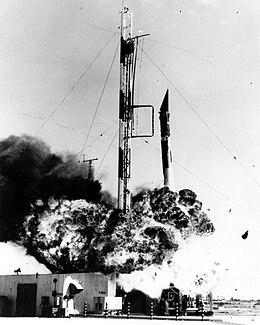Vanguard TV3

The Vanguard rocket explodes shortly after launch.
|
|
| Mission type | Earth science |
|---|---|
| Operator | Naval Research Laboratory (NRL) |
| Spacecraft properties | |
| Launch mass | 1.36 kilograms (3.0 lb) |
| Start of mission | |
| Launch date | December 6, 1957, 16:44:34 UTC |
| Rocket | Vanguard |
| Launch site | Cape Canaveral LC-18A |
| Orbital parameters | |
| Reference system | Geocentric |
| Epoch | Planned |
Vanguard TV3, also called Vanguard Test Vehicle Three was the first attempt of the United States to launch a satellite into orbit around the Earth. Vanguard 1A was a small satellite designed to test the launch capabilities of the three-stage Vanguard and study the effects of the environment on a satellite and its systems in Earth orbit. It was also to be used to obtain geodetic measurements through orbit analysis. Solar cells on Vanguard 1A were manufactured by Bell Laboratories.
At its launch attempt on December 6, 1957 at Cape Canaveral, the booster ignited and began to rise; but about two seconds after liftoff, after rising about four feet (1.2 m), the rocket lost thrust and began to fall back to the launch pad. As it settled the fuel tanks ruptured and exploded, destroying the rocket and severely damaging the launch pad. The Vanguard satellite was thrown clear and landed on the ground a short distance away with its transmitters still sending out a beacon signal. The satellite was damaged, however, and could not be reused. It is now on display at the National Air and Space Museum of the Smithsonian Institution.
The exact cause of the accident was not determined with certainty due to limited telemetry instrumentation at this early phase, but Martin-Marietta concluded that low fuel tank pressure during the start procedure allowed some of the burning fuel in the combustion chamber to leak into the fuel system through the injector head before full propellant pressure was obtained from the turbopump. GE on the other hand argued that the culprit was a loose fuel connection, and the actual truth appeared to be somewhere in-between. Investigation concluded that tank and fuel system pressure were slightly lower than nominal, which resulted in insufficient pressure in the injector head. As a result, hot combustion gas backed up into the injector head and caused a large pressure spike. The injector rings completely burned through, followed by rupture of the combustion chamber. At T+1 second, a shock wave in the thrust section of the booster ruptured a fuel feed line, completely terminating engine thrust. GE technicians had failed to catch this design flaw during testing and a temporary fix was made by increasing tank pressure. Eventually, a further modification was made by using ethane gas to increase fuel force and prevent rough start transients. The X-405 engine did not fail again on subsequent launches and static firing tests.
...
Wikipedia
